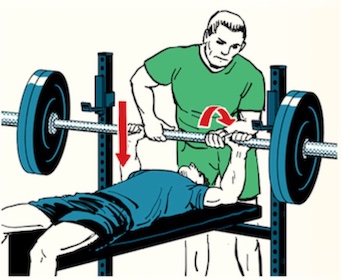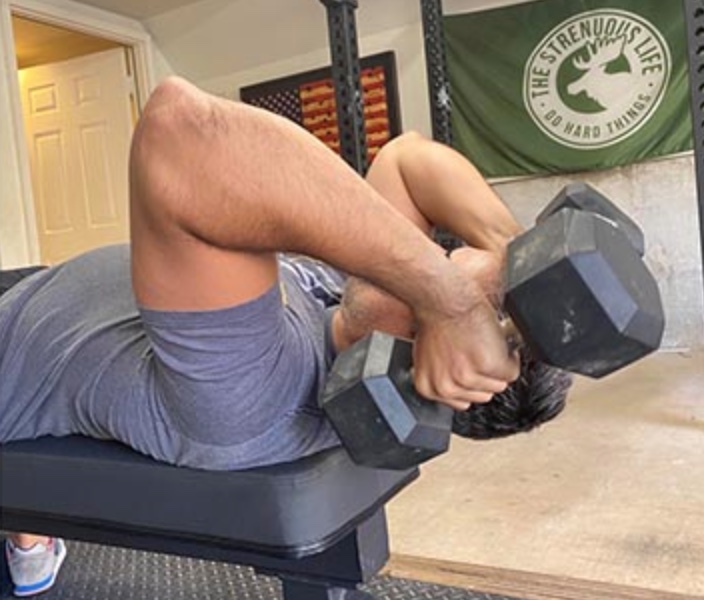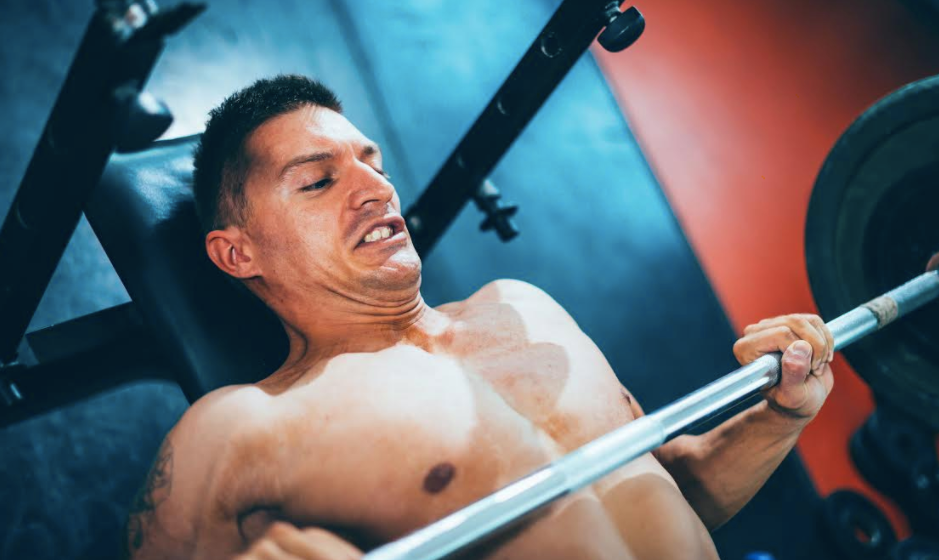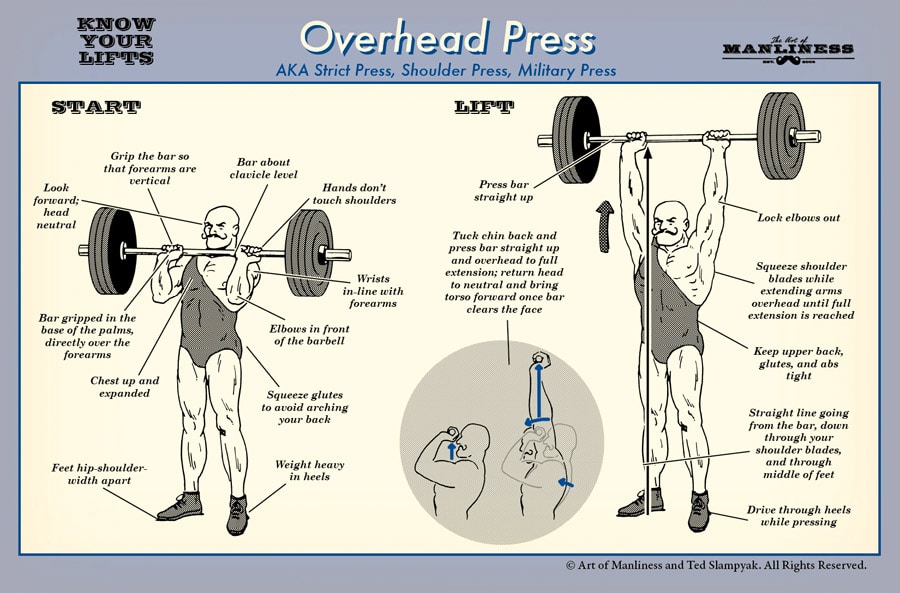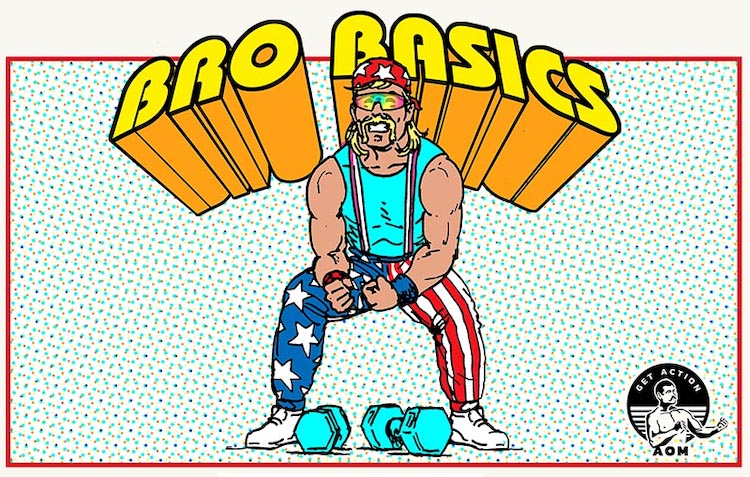
Welcome back to Bro Basics, a series that covers exercises that are popular and can be useful but are often done inadequately and shows the exercises’ broader function and how to perform them correctly.
Bros do a lot of isolation moves like the exercises we’ve covered in this series so far: the tricep extension, the bicep curl, and the lat pull-down. When they do do one of the major “big four” lifts, it’s typically the bench press.
The bench press is popular with bodybuilder bros and serious powerlifters alike because it’s an exercise that produces both functional and aesthetic results. Plus, it provides a ready (if not comprehensive) measure of someone’s overall strength. Dudes enjoy asking each other, “How much ya bench?”
If you’d like to bench greater tonnage, you have to know more about this lift than how to rack more plates on the bar; you’ve got to learn how to bench efficiently. We’ll cover that below, as well as much more on this mother of all bro basics.
What Muscles Does the Bench Press Work?
The bench press primarily works the pectoralis major (chest), anterior deltoids (front of shoulders), and triceps.
The fact that it works those latter muscles allows it to help you develop big guns. As we discussed in our article about tricep extensions, the tricep muscles make up most of your arm girth. If you want big arms, you need to work them out. You work your tricep muscles on the bench press during the lockout portion of the lift.
Besides your chest, shoulders, and triceps, the bench press also works your forearms and lats. It’s a great all-around upper-body exercise.
Why Do the Bench Press?
You get a lot of bang for your buck. As mentioned above, the bench press works several large muscles in your upper body, particularly your chest. So you get a lot of bang for your buck with a single lift. If you want to increase upper-body strength and size, the bench press will help you do that.
Helps give you that masculine v-shaped torso. This is undoubtedly a main reason men bench press. Amongst the physical traits that make men sexually attractive, the v-shaped torso — large chest, shoulder, and back muscles that taper down to a narrower waist — arguably reigns supreme. To increase the size of the top part of the v, you need to work your shoulders, chest, and back. The bench press does that.
It’s fun. The bench press is a fun lift. You’re hoisting a lot of weight over your face while lying on a bench. If you don’t perform the lift correctly and safely, you could seriously injure yourself or even die. That element of risk gives the bench press a bit of a manly thrill.
How to Bench Press
Setting Up Your Equipment
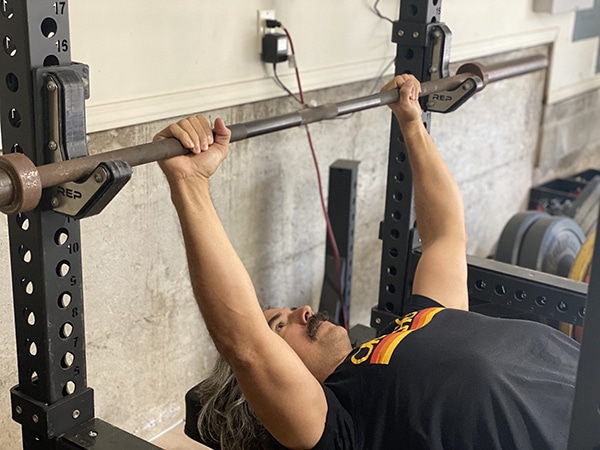
J-cups are set so that when you grab the bar, your elbows are slightly bent.
If you’re using a bench with built-in uprights — a configuration you’ll find in most commercial gyms — setting up the equipment for the bench press is a no-brainer. Just put the bar in the uprights and you’re good to go.
If you’re working out at home in your garage gym, you’ll likely be using your power rack as the uprights, so you’ll need to think about the optimal height to place the j-cups so you can properly get in your bench press starting position and unrack the bar.
You want to set your j-cups on your power rack so that your arms are slightly bent when you grab the bar.
If your j-cups are too high, your arms will be straight when you grab the bar. To get the bar out of the j-cups, you’ll have to shrug your shoulders forward or lift your butt off the bench. This, in turn, will take you out of the proper position for efficient bench pressing.
If the j-cups are too low, your arms will be very bent when you grab the bar. Getting the bar off the j-cups will require you to do half a bench press rep and will likely put you out of position to bench efficiently.
So set the j-cups so that your arms will be in the Goldilocks position when you grab the bar: not too straight and not too bent.
Lie Down on the Bench, Eyes One Inch in Front of the Bar
Lie down on the bench and slide yourself up or down so that your eyes are about one inch in front of the bar when you’re looking up at the ceiling. This position will prevent the barbell from hitting the j-cups when you press it up.
Feet Flat on the Floor
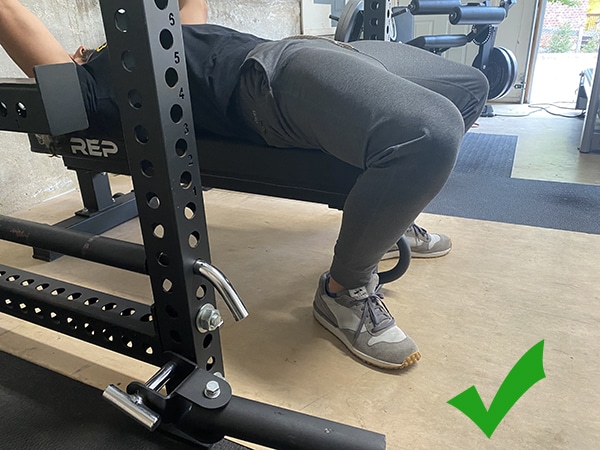
Place your feet flat on the floor so your knee is at about a 90-degree angle. It’s okay if your knee angle is slightly acute. This foot position will provide you with the stability you need to safely bench press and allow you to use your feet to drive against the floor as you lift the bar.
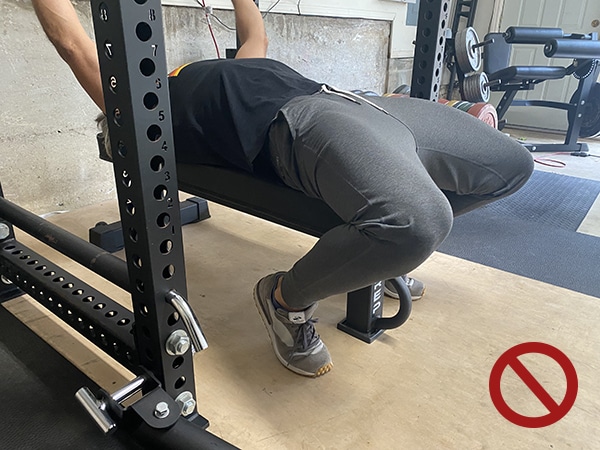
Some people like to place their feet back so they’re closer to the hips and create a very acute angle with the knee. To achieve this acuteness, people will often just have their toes on the floor. They do this because it helps make their lower back arch up. While, as we’ll discuss in a bit, you do want your back to arch a little while you lift, this foot placement creates too much arch, causing the butt to come off the bench and leading you to bridge your bench press. Not only would this be illegal in a competition, but you’re cheating yourself from working all the muscles involved in this lift.
If your legs are too short to put flat on the floor, you can place plates beneath your feet.
Grab the Bar

Grab the bar so that your hands are about a full hand’s width from the break in the knurling in the middle of the barbell. An easy way to check for proper hand placement is to make sure your pinkies are close to the first grip mark on the barbell.
When you grab the bar, rotate your hands in slightly so that the bar sits across your palm.

Squeeze the bar with your hands and wrap your thumbs around the bar.
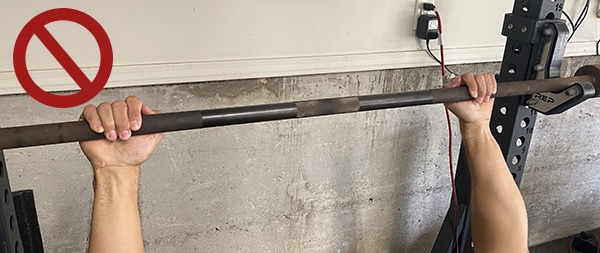
Do not use a thumbless grip! It’s called a “suicide grip” for a reason. If the barbell slips in your hand, there’s no thumb in the way to prevent it from slipping right out of your hands and crashing on your face or chest.
Thumbs around the barbell at all times when you’re bench pressing.
Set the Arch in Your Back
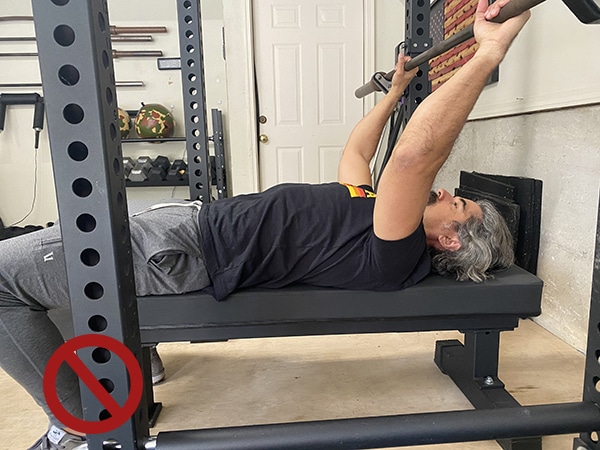
When most people bench press, they lie down with the entirety of their back flat on the bench. This is incorrect.
You want a bit of an arch in your back so that there’s some space between your lower back and the bench while your upper back and butt remain in contact with the bench.
Back arch does a couple things.
First, it reduces the range of motion of the bench press. When you don’t arch your back and therefore bench press while your back is flat and chest is lower, you have to press the bar farther up. When you arch your lower back, your chest comes up, shortening the bar’s path.
Second, the low back arch puts your shoulders in a position to generate more force when you bench press.
Setting the arch in your back is counterintuitive for beginners, so it may take a bit of practice to get it right.

With your hands gripping the bar, imagine trying to pinch the vinyl or leather of the bench between your shoulder blades. This will lead you to retract your scapulas, causing your chest to puff up.
You want to keep your shoulder blades squeezed together for the entirety of the lift. This gets hard to do as the weight gets heavier or as you do more reps. But it’s essential to ensure an efficient bench press.
To add to the arch a bit more, use leg drive. We’ll talk more about leg drive here in a bit, but during the setup, think about pressing yourself backward on the bench with your legs. Doing this will bolster your arch. You don’t actually want to move backward on the bench; just use this as a physical cue for proper position.
Move the Bar to Starting Position
With your hands gripping the bar and your back arch set, you’re ready to lift the bar off the j-cups and move it to the bench press starting position.
Straighten your elbows. This will take the barbell out of the j-cups. With your elbows straight and locked out, move the barbell forward until it’s directly over the shoulder joint. This is the bench press starting position or lockout position (what it looks like is depicted above).
Make sure you’re engaging in leg drive at this point by pushing yourself back on the bench with your legs. You’ll want to maintain this leg drive throughout the lift.
Lower the Bar to Your Sternum
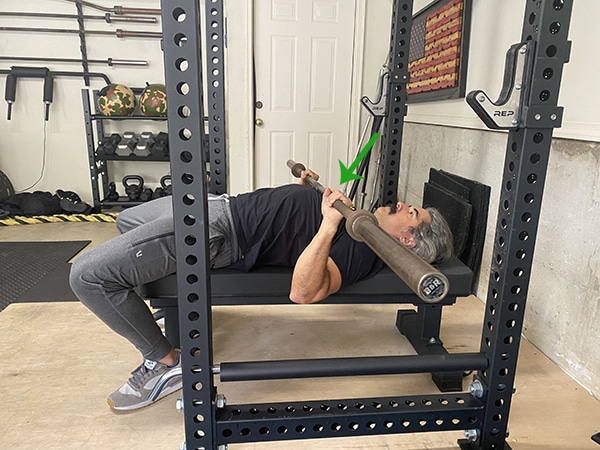
Perform the Valsalva maneuver.
Keeping your wrists straight, lower the bar towards your chest.
When most dudes bench press, they lower the bar straight down so that the bar touches the top part of their chest. This will set you up for shoulder impingement and is also inefficient.
Instead, lower the bar and touch it somewhere near your sternum. Where it touches your sternum depends on your body’s anthropometry and your grip width. Lowering the bar towards your sternum will result in a diagonal bar path. It will also result in your elbows being slightly in front of the bar when the bar touches your chest.
You want the barbell to touch your chest gently. Don’t let it bounce off your chest. Imagine you have a piece of glass on your chest and want to tap it with the barbell but not break it.
I like to pause for about one second with the barbell on my chest instead of just touching and going back up.
Continue to leg drive and continue to perform the Valsalva maneuver.
Push the Bar Up and Back to the Starting Position
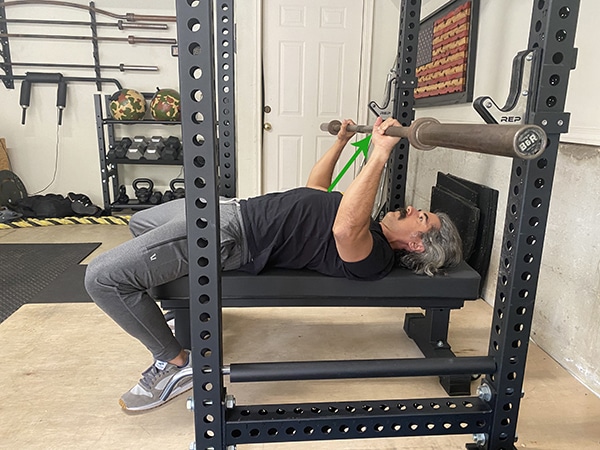
Push the bar up and back to the starting position with the barbell over your shoulder joint. Again, this will result in a slightly diagonal bar path. For many beginning bench pressers, this bar path is counterintuitive; they want to push the bar straight up.
A few cues that I use to help me keep the up and back bar path are “eyes” and “elbows.”
“Eyes” reminds me to push the bar back towards my eyes.
“Elbows” reminds me to keep my elbows tucked in. Keeping your elbows tucked in will help maintain that diagonal bar path up. I have a tendency to let my elbows flare out when I’m pushing the bar up — especially when things get heavy — and this results in a bar path that goes up but not back.
Take a Deep Breath; Perform Valsalva; Repeat
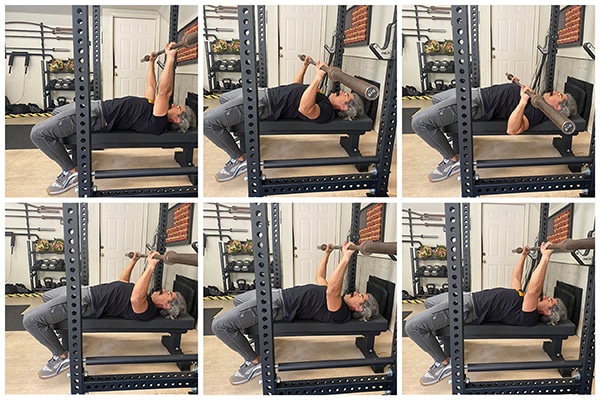
After completing a rep, take a big, fresh breath, perform the Valsalva, and repeat for the prescribed reps.
Bench Press Safety
The bench press can kill you. It’s the one lift where the barbell is directly above your throat and the vital organs in your upper body, and there’s no way to bail out if you fail the lift.
Because the bench press can potentially kill you, you want to take extra precautions to ensure your safety during the lift. One of those precautions is using a spotter.
But there’s a right and wrong way to spot someone on the bench press. Review our guide on how to spot someone on the bench press for more details.
If you don’t have someone who can spot you on the bench press, follow these four safety rules so that you can bench press alone and live to tell the tale of your legendary PR.
Tags: Bro Basics


